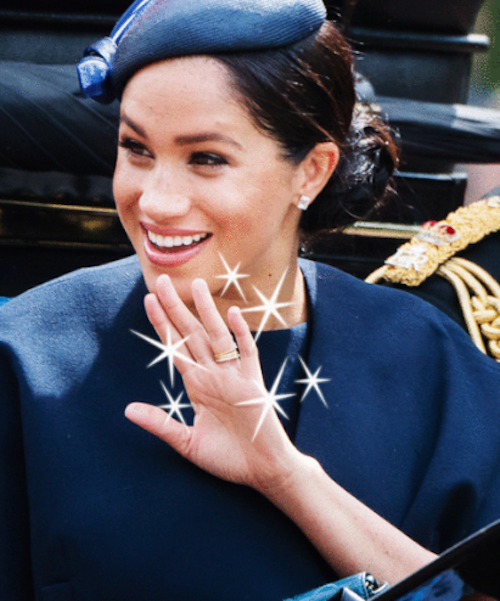The Less-Than-Eternal Tradition Behind Eternity Rings
The unbroken band of diamonds makes a stunning statement—but the symbol of eternal love is more a result of marketing than tradition
Keen royal watchers spotted a little something extra on the Duchess of Sussex Meghan Markle’s waving hand at Trooping the Colour last Saturday. Alongside her three-stone engagement ring and Welsh-gold wedding band, there was a brand-new, third sparkling ring on her royal finger, one that jewelry buffs recognized immediately as an eternity ring.
An a-what-a-dee ring? An eternity ring, also known as an infinity ring, is a simple band with identically cut gemstones (preferably diamonds, naturally) along its circumference. (A much cheaper variety with diamonds on only one side is called, less romantically, a half eternity ring.)
The eternity ring is just as it sounds: 360 degrees of perfectly spaced diamonds in a tight line. There’s no room for a sizing bar, so wearers can’t adjust the size to reuse Grandma’s or Great Aunt Alice’s heirloom; anyone in the market for an eternity ring will almost certainly need to purchase and personalize their own. It’s a meticulous and time-consuming task for jewelry-makers, and it’s priced accordingly. The least expensive one sold at Tiffany’s costs $2,200.
Keen royal watchers spotted a little something extra on the Duchess of Sussex Meghan Markle’s waving hand at Trooping the Colour last Saturday. Alongside her three-stone engagement ring and Welsh-gold wedding band, there was a brand-new, third sparkling ring on her royal finger, one that jewelry buffs recognized immediately as an eternity ring.
An a-what-a-dee ring? An eternity ring, also known as an infinity ring, is a simple band with identically cut gemstones (preferably diamonds, naturally) along its circumference. (A much cheaper variety with diamonds on only one side is called, less romantically, a half eternity ring.)
The eternity ring is just as it sounds: 360 degrees of perfectly spaced diamonds in a tight line. There’s no room for a sizing bar, so wearers can’t adjust the size to reuse Grandma’s or Great Aunt Alice’s heirloom; anyone in the market for an eternity ring will almost certainly need to purchase and personalize their own. It’s a meticulous and time-consuming task for jewelry-makers, and it’s priced accordingly. The least expensive one sold at Tiffany’s costs $2,200.
Big Diamond would have you believe the eternity ring’s roots began in exotic and glamorous ancient Egypt, where a fervent belief in the afterlife meant death didn’t actually do you part—it solidified your matrimonial vows into infinity and beyond. But not unlike the way De Beers co-opted the European aristocracy’s “betrothal rings” into post-war, modern-day engagement rings, eternity rings are an only partly traditional idea that’s been repackaged and sold to modern brides.
In this case, diamond sellers in the 1950s were facing twin problems: married women were not buying nearly enough diamonds, and newly found Soviet diamonds were threatening De Beers’s monopoly over the industry. De Beers bought out the Russian diamond inventory—even and especially the smallest ones, unfit to be an engagement-worthy solitaire that was the de rigueur fashion of the time. Then De Beers solved its other problem with a campaign summed up by this elegant slogan: “She married you for richer or poorer. Let her know how it’s going.”
The eternity ring was initially marketed as a way to celebrate a couple’s Golden 50th Anniversary—an occasion that the U.S. Census estimates only 6% of married couples reach. In fact, the event is rare enough that you can still request an official anniversary greeting from the White House should you make it so far (no guarantees, but they’ll try). The Queen will do the same on a couple’s 60th anniversary and not a moment sooner.
Only a tiny number of brides would ever legitimately wear a 50th anniversary eternity ring, but luckily for the diamond-sellers, those who dared to wear the style despite convention were the most glamorous women of their eras. Marilyn Monroe wore a platinum band with 35 baguette-cut diamonds from Joe DiMaggio; Audrey Hepburn chose a pair of infinity bands in each of white and pink gold; Grace Kelly said yes to a Cartier version with rubies; and Elizabeth Taylor chose the eternity style for not one but both weddings to Richard Burton.
Celebrities then and now love the ring’s sleek look, but royalty—legit and wannabe—particularly loves the eternity ring for everything it represents. The delicate diamonds make it difficult for everyday wear by regular folk—commoners who do dishes and laundry, forget it—so eternity rings are like white gloves, a way to signify luxury and lifestyle. The Duchess of Windsor Wallis Simpson proudly wore a gold and diamond eternity band throughout her 20-year marriage to would-have-been king Edward VIII, and in 1995, American royalty John F. Kennedy Jr. chose a sapphire and diamond band to propose to Carolyn Bessette.
No wonder a new generation of young royals, especially the marrying-in kind like duchesses Meghan and Kate, are fans of this particular kind of bling. Rumor has it that Meghan’s celebrates her first anniversary (a new record, perhaps), while Kate’s doubled as a push present after the birth of Prince George. Both rings cement and showcase their status, and their intention to enjoy said standing for a long time. An eternity, you might say.
